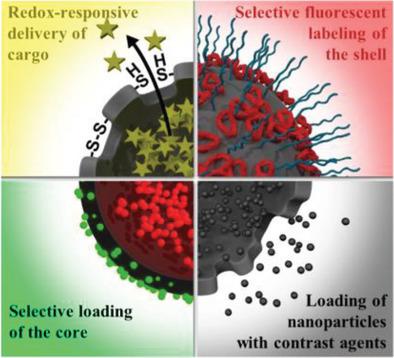当前位置:
X-MOL 学术
›
Part. Part. Syst. Charact.
›
论文详情
Our official English website, www.x-mol.net, welcomes your
feedback! (Note: you will need to create a separate account there.)
Versatile Preparation of Silica Nanocapsules for Biomedical Applications
Particle & Particle Systems Characterization ( IF 2.7 ) Pub Date : 2020-03-17 , DOI: 10.1002/ppsc.201900484 Shuai Jiang 1 , Milagro Mottola 1, 2, 3 , Shen Han 1 , Raweewan Thiramanas 1 , Robert Graf 1 , Ingo Lieberwirth 1 , Volker Mailänder 1, 4 , Daniel Crespy 1, 5 , Katharina Landfester 1
Particle & Particle Systems Characterization ( IF 2.7 ) Pub Date : 2020-03-17 , DOI: 10.1002/ppsc.201900484 Shuai Jiang 1 , Milagro Mottola 1, 2, 3 , Shen Han 1 , Raweewan Thiramanas 1 , Robert Graf 1 , Ingo Lieberwirth 1 , Volker Mailänder 1, 4 , Daniel Crespy 1, 5 , Katharina Landfester 1
Affiliation

|
Core–shell nanocapsules are receiving increasing interest for drug delivery applications. Silica nanocapsules have been the focus of intensive studies due to their biocompatibility, versatile silica chemistry, and tunable porosity. However, a versatile one‐step preparation of silica nanocapsules with well‐defined core–shell structure, tunable size, flexible interior loading, and tailored shell composition, permeability, and surface functionalization for site‐specific drug release and therapeutic tracking remains a challenge. Herein, an interfacially confined sol–gel process in miniemulsion for the one‐step versatile preparation of functional silica nanocapsules is developed. Uniform nanocapsules with diameters from 60 to 400 nm are obtained and a large variety of hydrophobic liquids are encapsulated in the core. When solvents with low boiling point are loaded, subsequent solvent evaporation converts the initially hydrophobic cavity into an aqueous environment. Stimuli‐responsive permeability of nanocapsules is programmed by introducing disulfide or tetrasulfide bonds in the shell. Selective and sustained release of dexamethasone in response to glutathione tripeptide for over 10 d is achieved. Fluorescence labeling of the silica shell and magnetic loading in the internal cavity enable therapeutic tracking of nanocapsules by fluorescence and electron microscopies. Thus, silica nanocapsules represent a promising theranostic nanoplatform for targeted drug delivery applications.
中文翻译:

用于生物医学应用的二氧化硅纳米胶囊的多功能制备
核壳纳米胶囊对药物递送应用的兴趣日益增加。二氧化硅纳米胶囊由于其生物相容性,通用的二氧化硅化学和可调节的孔隙率而成为深入研究的重点。然而,具有确定的核-壳结构,可调大小,灵活的内部载荷,定制的壳组成,渗透性和表面功能化以实现特定位置的药物释放和治疗跟踪的多功能一步法制备二氧化硅纳米胶囊仍然是一个挑战。本文中,开发了一种界面乳化溶胶-凝胶法,用于一步法制备功能性二氧化硅纳米胶囊。获得了直径为60至400 nm的均匀纳米胶囊,并且将各种各样的疏水性液体包裹在核中。当装入低沸点溶剂时,随后的溶剂蒸发会将最初的疏水腔转化为水性环境。通过在壳中引入二硫键或四硫键来编程纳米胶囊的刺激响应渗透性。实现了对谷胱甘肽三肽的选择性地塞米松的持续释放超过10天。硅胶壳的荧光标记和内部空腔中的磁性负载使荧光和电子显微镜检查能够对纳米胶囊进行治疗性追踪。因此,二氧化硅纳米胶囊代表了用于靶向药物递送应用的有希望的治疗学纳米平台。通过在壳中引入二硫键或四硫键来编程纳米胶囊的刺激响应渗透性。实现了对谷胱甘肽三肽的选择性地塞米松的持续释放超过10天。硅胶壳的荧光标记和内部空腔中的磁性负载使荧光和电子显微镜检查能够对纳米胶囊进行治疗性追踪。因此,二氧化硅纳米胶囊代表了用于靶向药物递送应用的有希望的治疗学纳米平台。通过在壳中引入二硫键或四硫键来编程纳米胶囊的刺激响应渗透性。实现了对谷胱甘肽三肽的选择性地塞米松的持续释放超过10天。硅胶壳的荧光标记和内部空腔中的磁性负载使荧光和电子显微镜检查能够对纳米胶囊进行治疗性追踪。因此,二氧化硅纳米胶囊代表了用于靶向药物递送应用的有希望的治疗学纳米平台。硅胶壳的荧光标记和内部空腔中的磁性负载使荧光和电子显微镜检查能够对纳米胶囊进行治疗性追踪。因此,二氧化硅纳米胶囊代表了用于靶向药物递送应用的有希望的治疗学纳米平台。硅胶外壳的荧光标记和内部空腔中的磁性负载使荧光和电子显微镜检查能够对纳米胶囊进行治疗性追踪。因此,二氧化硅纳米胶囊代表了用于靶向药物递送应用的有希望的治疗学纳米平台。
更新日期:2020-03-17
中文翻译:

用于生物医学应用的二氧化硅纳米胶囊的多功能制备
核壳纳米胶囊对药物递送应用的兴趣日益增加。二氧化硅纳米胶囊由于其生物相容性,通用的二氧化硅化学和可调节的孔隙率而成为深入研究的重点。然而,具有确定的核-壳结构,可调大小,灵活的内部载荷,定制的壳组成,渗透性和表面功能化以实现特定位置的药物释放和治疗跟踪的多功能一步法制备二氧化硅纳米胶囊仍然是一个挑战。本文中,开发了一种界面乳化溶胶-凝胶法,用于一步法制备功能性二氧化硅纳米胶囊。获得了直径为60至400 nm的均匀纳米胶囊,并且将各种各样的疏水性液体包裹在核中。当装入低沸点溶剂时,随后的溶剂蒸发会将最初的疏水腔转化为水性环境。通过在壳中引入二硫键或四硫键来编程纳米胶囊的刺激响应渗透性。实现了对谷胱甘肽三肽的选择性地塞米松的持续释放超过10天。硅胶壳的荧光标记和内部空腔中的磁性负载使荧光和电子显微镜检查能够对纳米胶囊进行治疗性追踪。因此,二氧化硅纳米胶囊代表了用于靶向药物递送应用的有希望的治疗学纳米平台。通过在壳中引入二硫键或四硫键来编程纳米胶囊的刺激响应渗透性。实现了对谷胱甘肽三肽的选择性地塞米松的持续释放超过10天。硅胶壳的荧光标记和内部空腔中的磁性负载使荧光和电子显微镜检查能够对纳米胶囊进行治疗性追踪。因此,二氧化硅纳米胶囊代表了用于靶向药物递送应用的有希望的治疗学纳米平台。通过在壳中引入二硫键或四硫键来编程纳米胶囊的刺激响应渗透性。实现了对谷胱甘肽三肽的选择性地塞米松的持续释放超过10天。硅胶壳的荧光标记和内部空腔中的磁性负载使荧光和电子显微镜检查能够对纳米胶囊进行治疗性追踪。因此,二氧化硅纳米胶囊代表了用于靶向药物递送应用的有希望的治疗学纳米平台。硅胶壳的荧光标记和内部空腔中的磁性负载使荧光和电子显微镜检查能够对纳米胶囊进行治疗性追踪。因此,二氧化硅纳米胶囊代表了用于靶向药物递送应用的有希望的治疗学纳米平台。硅胶外壳的荧光标记和内部空腔中的磁性负载使荧光和电子显微镜检查能够对纳米胶囊进行治疗性追踪。因此,二氧化硅纳米胶囊代表了用于靶向药物递送应用的有希望的治疗学纳米平台。











































 京公网安备 11010802027423号
京公网安备 11010802027423号